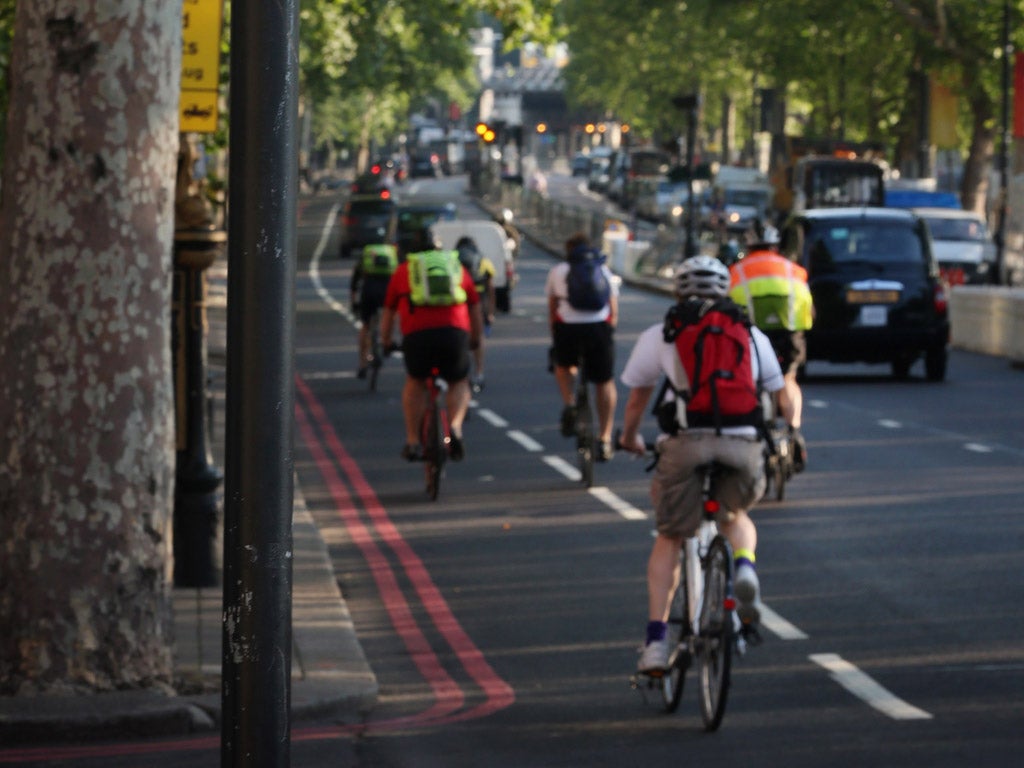Keep cycling deaths in perspective
Recent tragedies in London shouldn’t force us off our bikes. Here are some tips to help cyclists stay safe on the roads

Your support helps us to tell the story
From reproductive rights to climate change to Big Tech, The Independent is on the ground when the story is developing. Whether it's investigating the financials of Elon Musk's pro-Trump PAC or producing our latest documentary, 'The A Word', which shines a light on the American women fighting for reproductive rights, we know how important it is to parse out the facts from the messaging.
At such a critical moment in US history, we need reporters on the ground. Your donation allows us to keep sending journalists to speak to both sides of the story.
The Independent is trusted by Americans across the entire political spectrum. And unlike many other quality news outlets, we choose not to lock Americans out of our reporting and analysis with paywalls. We believe quality journalism should be available to everyone, paid for by those who can afford it.
Your support makes all the difference.No sooner had Londoners absorbed the awful news of the fourth cyclist death in eight days - reported on the front page of the capital’s free Evening Standard under a large photo of a sickeningly mangled bicycle (it was impossible not to imagine what its rider looked like) - than a fifth rider fell under the wheels of a bus late last night.
Five deaths in almost as many days surely represents an unprecedented sequence of horror, and has rightly lead to soul-searching in London and beyond. Huge amounts of work still needs to be done to improve safety, not least at known danger areas. In the meantime, as five families grieve, those who cycle or would cycle have a choice: panic and flee to the buses; or step back, take stock, and ride on.
Firstly - and this will come as no consolation to anyone directly affected by these deaths - perspective is important. Last year, there were 14 cyclist deaths in London, and 16 the year before. So far this year there have been 13. The past eight days have been dreadful, but there remains a good chance that, with six weeks of the year to run, 2013 will not be the capital’s deadliest.
This would be in spite of ongoing increases in the number of people riding. In 2011, there were 180 million cycle journeys in London, or half a million, on average, every day. That number will be higher now but in 2011, just 16 journeys out of 180 million ended in death, or one in every 11.25 million journeys. Each death is one too many, and each death represents carnage to the rider and those around him or her, but the stats don’t lie: cycling is safe.
It can be safer, of course, and must be. And it is no insult to those who have died this week for each cyclist to do the only thing he or she can - and ride as safely as possible while the campaign continues for roads to become safer. This applies particularly to new cyclists and/or cyclists who do not drive (an understanding of how traffic works is useful for any cyclist, I believe).
These, for what they’re worth, are my tips:
1 Avoid lorries
Never wait between the kerb and a lorry at a junction. If it turns left, the driver may not see you. Stay well behind or, preferably, in front, where you can be seen.
2 Don’t kerb-crawl
The kerb is not your friend. Keep a line towards the middle of the lane so that drivers have to steer around you. Hugging the pavement only invites them to scrape past.
3 Show your face
Eyeballing drivers at junctions helps them to view you as a fellow road user they would rather not run over. Do the same to vehicles on your tail. Smiling helps, too.
4 Use your neck
Learn how to look over your shoulder without wobbling and do so regularly – and always before making a manoeuvre, when you should also stick out an arm.
5 Obey the code
It can be safer, say, to jump a red light than wait in the shadow of a lorry but egregious violation of the Highway Code can damage you – and the image of cyclists.
6 Overtake buses
If you’re approaching a bus at a stop, look over your shoulder, eyeball drivers, and move to overtake. If you can’t, wait a good distance behind the bus. Never undertake.
7 Be bright
It’s more important to show your face and position yourself well, but bright clothing, strong lights and reflectors, while rarely cool, will also help you get noticed.
8 Wear a helmet
You may look like a dork and it’s totally your choice but, on balance, you’re better off with a helmet. Just don’t think it will protect anything else – or do anything to resist a 40-tonne truck.
9 Don’t get cross
Sure, drivers can be infuriating but banging on windows or cursing across junctions will only reinforce the view held by a dangerous minority that cyclists are enemies.
10 Plan your route
It stands to reason that you’re probably more vulnerable in three lanes of traffic doing 40mph than on a residential side street, or on junctions known to be dangerous.
Bonus: Find a friend
If you’re a new or lapsed cyclist, venture out first with a more experienced friend. Keep a good distance behind and watch what he or she does. Then let them follow you and take their advice.
Join our commenting forum
Join thought-provoking conversations, follow other Independent readers and see their replies
Comments